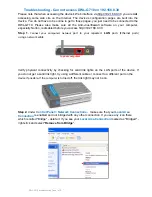
Trango
Systems,
Inc
TL45
User
Manual
Rev
2.0r3
LT
‐
9037A
August
15,
2011
Page
27
Yellow
LED
4
:
Begins
blinking
when
RSSI
is
greater
or
equal
to
–60
dBm.
On
solid
at
–55
dBm.
This
is
the
rightmost
LED.
If
no
VALID
MU
or
RU
signal
is
detected
the
LEDs
will
not
be
on
at
all.
In
addition,
these
4
LEDs
shall
flash
ON
for
2
seconds,
then
OFF
for
2
seconds
to
indicate
the
'factory
reset'
button
has
been
activated
and
the
reset
successful.
ASSOC
iation
LED
(green):
The
ASSOC
led
blinks
at
the
following
rates:
‐
Once
every
second
when
unit
is
powered
on
but
opmode
is
OFF.
‐
Twice
per
second
while
in
opmode
ON
and
scanning
for
an
MU
or
RU.
‐
Solid
after
unit
is
associated
with
the
RU
or
MU.
RF
Link
Loopback
Test
(linktest
command)
The
linktest
command
is
the
primary
tool
to
assess
the
quality
of
the
link
when
opmode
is
on.
The
linktest
command
tests
the
throughput
and
packet
error
rate
(PER)
on
the
current
channel
for
each
direction
at
all
speeds
and
reports
results.
This
command
also
provides
RSSI
for
both
ends
of
the
wireless
link.
The
command
can
be
run
from
either
the
MU
or
the
RU.
The
linktest
uses
FEC
but
does
NOT
use
ARQ,
so
all
errors
on
the
link
are
reported.
Throughput
numbers
represent
the
absolute
maximum
bi
‐
directional
capacity
including
the
management
header
(which
is
not
available
for
user
payload)
so
actual
user
throughput
measurements
will
be
slightly
less.
In
running
the
linktest
command
the
user
must
specify
the
modulation
speed
for
each
end
of
the
link.
Command
format:
linktest
<loc
speed>
<peer
speed>.
Valid
modulation
speeds
are:
6,
12,
18,
24,
36,48,
and
54
Mbps.
Lower
speeds
will
result
in
fewer
dropped
packets.
Example:
# linktest 24 24
local tx rate = 24
Mbps peer
tx
rate = 24 Mbps packet
size = 1600 bytes
# of packets per period = 1000
# of Cycle = 10
0> [tx] 1000 [rx] 1000 [rssi] -37 peer: [tx] 1000 [rx] 1000 [rssi] -40 ->
22.01 Mbps
1> [tx] 1000 [rx] 1000 [rssi] -37 peer: [tx] 1000 [rx] 1000 [rssi] -40 ->
22.01 Mbps
2> [tx] 1000 [rx] 1000 [rssi] -37 peer: [tx] 1000 [rx] 1000 [rssi] -40 ->
22.01 Mbps
3> [tx] 1000 [rx] 1000 [rssi] -37 peer: [tx] 1000 [rx] 1000 [rssi] -40 ->
22.01 Mbps
4> [tx] 1000 [rx] 1000 [rssi] -37 peer: [tx] 1000 [rx] 1000 [rssi] -40 ->
22.01 Mbps
5> [tx] 1000 [rx] 1000 [rssi] -37 peer: [tx] 1000 [rx] 1000 [rssi] -40 ->
22.01 Mbps
6> [tx] 1000 [rx] 1000 [rssi] -37 peer: [tx] 1000 [rx] 1000 [rssi] -40 ->
22.01 Mbps
7> [tx] 1000 [rx] 1000 [rssi] -37 peer: [tx] 1000 [rx] 1000 [rssi] -40 ->
22.00 Mbps
8> [tx] 1000 [rx] 1000 [rssi] -36 peer: [tx] 1000 [rx] 1000 [rssi] -40 ->
22.01 Mbps
9> [tx] 1000 [rx] 1000 [rssi] -37 peer: [tx] 1000 [rx] 1000 [rssi] -40 ->
22.01 Mbps
--> [tx] 10000 [rx] 10000 [rssi] -36 peer: [tx] 10000 [rx] 10000 [rssi] -40
--> [Local PER]
0.00 %
[Peer PER]
0.00 %
Success.
#>
In
this
example
the
linktest
was
run
at
24
Mbps
at
each
end
of
the
link.
The
results
indicated
10
cycles
of
1000
packets
were
transmitted
and
received
from
each
end
of
the
link
without
error.
Actual
achievable
throughput
is
measured
at
22
Mbps.
















































